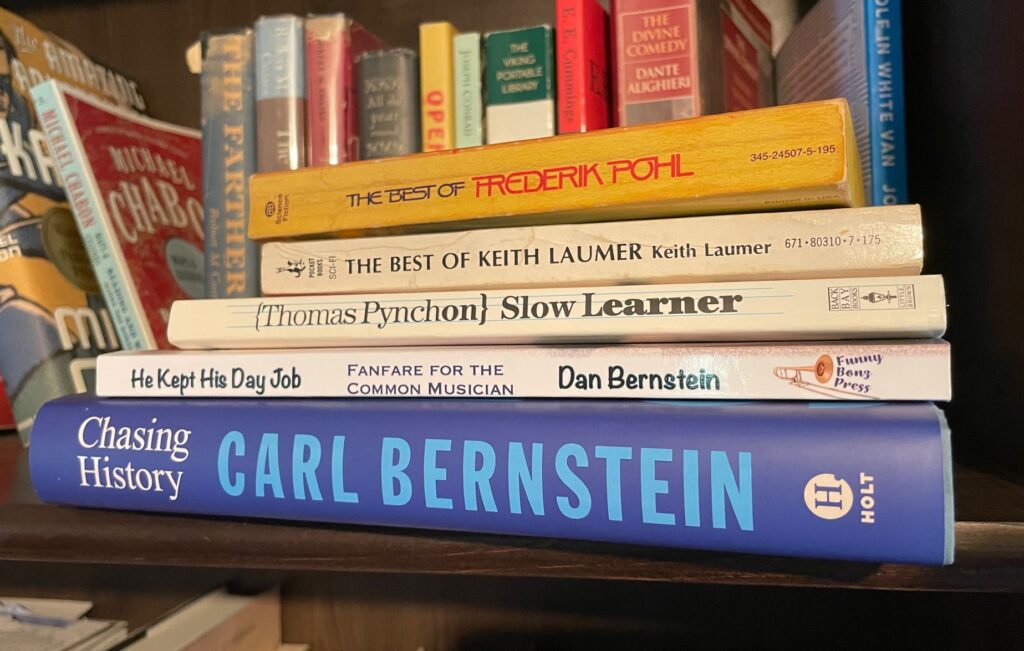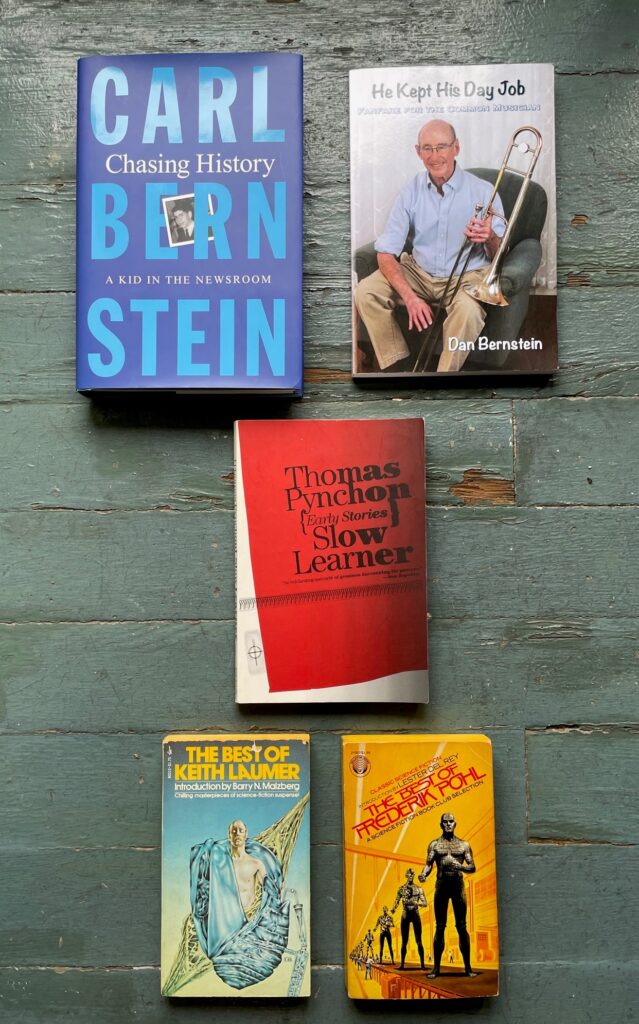Books acquired: “Tales of an Inland Empire Girl,” Juanita Mantz
Books read: “The Best of Frederik Pohl”; “The Best of Keith Laumer”; “Slow Learner,” Thomas Pynchon; “He Kept His Day Job: Fanfare for the Common Musician,” Dan Bernstein; “Chasing History: A Kid in the Newsroom,” Carl Bernstein
Welcome, readers, to my monthly post about the books I read the previous month. In May I finished five: three story collections and two memoirs by retired journalists with the same surname. Who says I don’t seek out variety?
“Best of Frederik Pohl” (1975): As many of these involve satirical warnings about advertising, public relations, politics and consumerism, these stories from 1954-1967 can still seem refreshing, their skepticism of future trends warranted. And “Day Million,” about sexual identity and practices of the distant future, is astonishingly prescient. These may not all be Pohl’s best, but they’re good to excellent. (However, the math essay “How to Count on Your Fingers” is baffling, as is its inclusion here.) (Bought in 2007 at Glendale’s BookFellows, RIP.)
“Best of Keith Laumer” (1976): These nine stories, published from 1961 to 1970, are sometimes elegiac, sometimes satiric. Laumer imagines a dormant war machine in a town square that springs to life, humans who transplant their consciousness at will into idealized forms stored in their closets and aliens bent on destroying Earth as part of a big-budget interstellar film epic. In a story from ’62, “Cocoon,” humans spend their days looking at a screen and lose all motor function. Where do SF writers get this crazy stuff? (Bought in 2007 at Anaheim’s Book Baron, RIP.)
“Slow Learner” (1984): This rounds up the famously private Pynchon’s college-era short stories and prefaces them with a modest, funny, self-critical introduction whose very existence is remarkable. It’s as if Salinger put 20 pages of autobiography at the head of “Nine Stories.” I’m not sure these stories are quite as bad as Pynchon makes them out to be. But other than “The Secret Integration,” they’re not very good either. (Bought in 2011 at North Hollywood’s Iliad Bookshop, very much still with us.)
“Chasing History” (2022): Rather than reflect on his glory days, Bernstein winningly focuses on the start of his career: learning the ropes at the Washington Star as a 16-year-old copy boy and progressing to taking dictation from reporters in the field and now and then getting his own byline. With assistance from a bunch of his old colleagues, he pieces together a vivid, detailed account of 1960-65 D.C., the Kennedy years, the civil rights era and the workings of a top-flight newsroom. It was worth documenting, although I can see how some would lose patience for 350 pages of it. (Received as a gift in 2023.)
“He Kept His Day Job” (2023): A slim, engaging memoir by a retired Riverside Press-Enterprise columnist, this focuses not on newspapers but on his sideline of music-making, starting with reluctant childhood music lessons through high school band, the Stanford Marching Band and various jazz and brass ensembles the trombonist has participated in since. The thesis is that some people regret having abandoned an instrument and Bernstein is here to offer encouragement. If you play, and especially if you play in a community band of some sort, this might be for you. Written as it is by a man who knew how to compress his thoughts and keep readers engaged, the stories never bog down. (Bought in 2023 from the author.)
Not a bad month. The Pohl collection was my favorite of the five. The Pynchon was kind of a dud. After the introduction threw so much shade on what was to come, I figured, correctly, that the book might have peaked right there and considered whether I should just scratch it off my to-be-read list. But at a modest 193 pages, it seemed like I might as well knock it off and claim credit for it. Not sure that was the right decision, but the world now knows that I read it, and perhaps that’s worth something.
Speaking of Pohl, I have a second story collection of his, “Platinum Pohl,” that is a true career best-of, from 1949 to 1996. There is very little overlap between the two. I actually began reading them both simultaneously, tackling the stories in order of publication year, bouncing between the two as needed. After finishing “Best of,” which ends in 1967, that means I’m about one-third of the way through “Platinum,” with 1968 through 1996 still ahead of me. It’s such a long book, some 500 trade paperback, small-ish print pages, that turning to it now is much less daunting than if I were starting it from scratch. Sometimes as readers we must trick ourselves, right? Look for that book here in July, probably.
Note that two of my books this month were acquired in 2007 and another in 2011, besides two from 2023. The backlog clearance continues.
How was your May, readers? What have you been reading? And has your reading strategy ever involved tricking yourself in some fashion into making a daunting book seem less daunting?
Next month: Across the ocean, across the sea.


